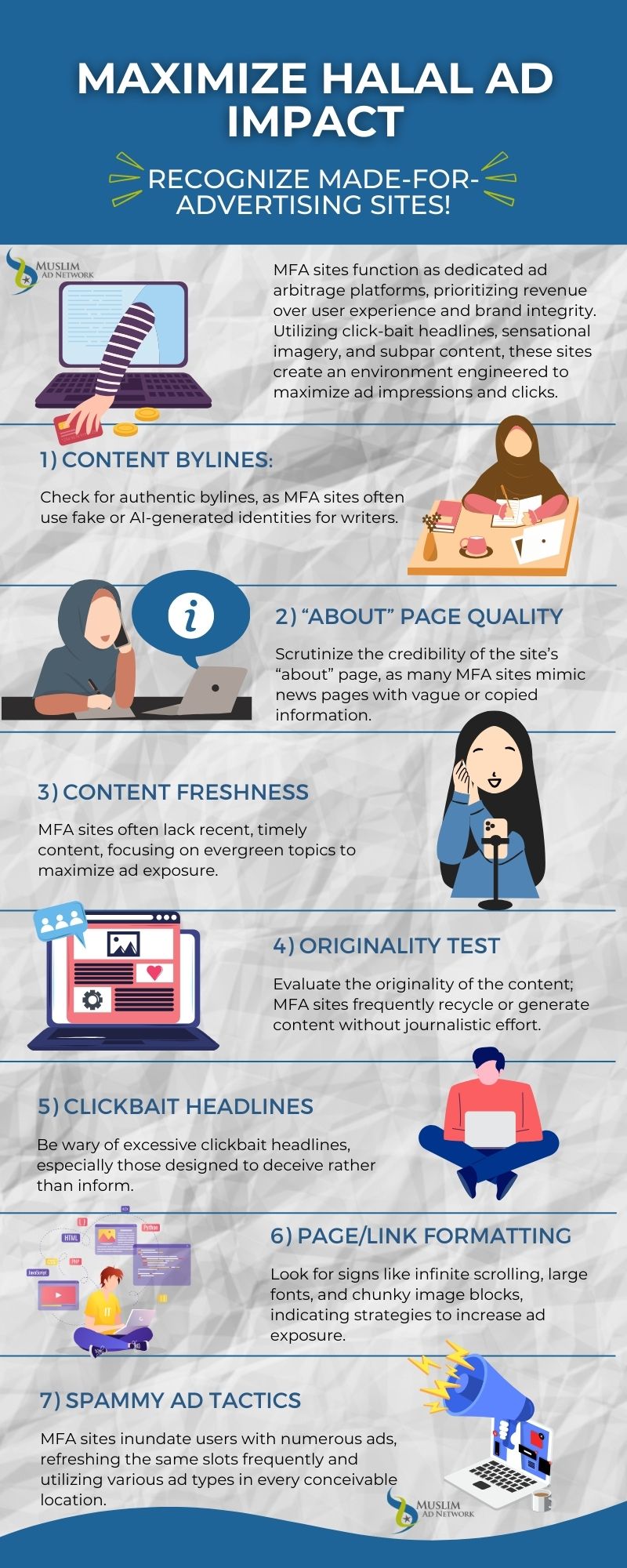
Understanding MFA Sites and Their Impact on Your Halal Ads
If you’ve spent any time online in the last two decades, you’ve likely encountered the allure of sensational headlines, luring you into slideshows and quirky content. These are the infamous made-for-advertising (MFA) sites.
In the expansive field of programmatic advertising, the persistent threat of MFA sites endures, causing unknown damage for unsuspecting halal advertisers.
MFA sites function as dedicated ad arbitrage platforms, prioritizing revenue over user experience and brand integrity. Utilizing click-bait headlines, sensational imagery, and subpar content, these sites create an environment engineered to maximize ad impressions and clicks.
MFA sites operate on a business model centered around acquiring cheap traffic and aggressively monetizing through excessive ads, content, and various elements, often lacking ethical considerations. While not illegal, they exist within gray areas of operation, presenting challenges for you and other advertisers seeking quality placements for ads targeting their Muslim audiences.
MFA websites thrive in the fragmented landscape of real-time bidding auctions, making it imperative for media buyers to navigate the gray areas of advertising. A halal ad media buyer’s job would be to identify and purchase ad space on channels that are relevant to the specific Muslim audience his brand sells products or services to at the optimal time, for the least amount of money.
Ironically, MFA sites thrive by exploiting ad inventory from reputable news and political sites, capitalizing on their lower ad costs, and presenting weak content as “brand safe” to attract major ad dollars. This paradox perpetuates the funding of biased and unreliable political sites, as advertisers unknowingly allocate budgets to MFA sites.
A recent RTB (Real-time bidding) Supply-Path Benchmarking report (login required) by Jounce Media underscores the need for vigilance, revealing that an average publisher monetizes on 24 supply-side platforms simultaneously, creating an environment ripe for MFA exploitation.
Despite attempts to curb such practices, a recent study by the Association of National Advertisers (ANA) uncovers a shocking resurgence of MFA sites, emphasizing the urgent need for you to strengthen your defenses. The ANA’s comprehensive study, analyzing $123 million of ad spend from 35 billion impressions, exposes the unsettling reality of MFA sites. Constituting 21% of paid impressions, these platforms drain advertisers’ programmatic display ad budgets, collectively generating a staggering $13 billion in revenue globally annually. The potent threat of MFA sites necessitates a closer examination of their inner workings and the risks they pose to your halal ad campaigns.
As AI-generated news sites proliferate, the MFA problem takes on new dimensions. These sites, capable of creating thousands of unreliable news outlets annually, thrive on programmatic ad revenue, posing a dual threat of misinformation and increased ad budget depletion. The ANA’s report sheds light on the unintended consequences of massive ad budgets, urging advertisers to recognize the long-term effects and act decisively.
Also read:
In another groundbreaking report from media research organization NewsGuard, shared with MIT Technology Review, a concerning trend emerges where AI chatbots populate junk websites with AI-generated content, drawing unsuspecting advertisers into a web of deception. The study reveals that over 140 major brands inadvertently fund ads on unreliable AI-written sites, raising alarms about the potential influx of glitchy, spam-ridden internet content and the massive waste of advertising dollars. With 90% of these ads served by Google, the situation highlights the urgent need for vigilance and oversight in the programmatic advertising landscape.
On the Environment: MFA sites emerge as major contributors to environmental degradation, generating 26% more carbon waste than non-MFA sites. Their extensive connections to supply-side platforms (SSPs) and resellers result in excessive carbon emissions, posing a threat to the sustainability goals of the digital media and advertising industry.
To understand why fighting digital carbon waste is important for Muslim consumers and businesses read: Why Your Halal Business Should Care About Digital Advertising Carbon Footprint.
You must be cautious of inherent risks, including strategically placed ads to prompt accidental clicks, hidden ads, and spammy content that devalues user engagement. The repercussions extend to tarnished brand reputation, poor ad performance, and compromised return on investment.
The ANA’s study serves as a clarion call for advertisers like yourself to reassess their digital ad strategies. With MFA sites contributing significantly to wasted programmatic ad spending, estimated at $20 billion in a global marketplace valued at $88 billion, you must take proactive measures. Delving into log-level data is imperative to identify and exclude unsavory content from media buys. Armed with the ANA’s insights and recommendations, you can embark on the journey to reclaim lost ad dollars and fortify your defenses against the MFA menace.
As you grapple with the challenge of MFAs intruding on your programmatic campaigns, the absence of standardized definitions from industry organizations like the Association for National Advertisers (ANA) and the Interactive Advertising Bureau (IAB) complicates matters.
While the ANA is set to release guidelines in October as part of its ongoing efforts, the IAB has not formally addressed the issue. IAB Tech Lab, emphasizes the need for industry-wide guardrails but acknowledges the variability in risk thresholds among buyers when determining what qualifies as an MFA.
How to Spot, Monitor, and Protect Your Halal Ads from MFA Sites

Navigating the MFA landscape requires a keen eye for their characteristics. Here are seven criteria to help advertisers identify if their ads are running on MFA sites:
- Content Bylines: Check for authentic bylines, as MFA sites often use fake or AI-generated identities for writers.
- “About” Page Quality: Scrutinize the credibility of the site’s “about” page, as many MFA sites mimic news pages with vague or copied information.
- Content Freshness: MFA sites often lack recent, timely content, focusing on evergreen topics to maximize ad exposure.
- Originality Test: Evaluate the originality of the content; MFA sites frequently recycle or generate content without journalistic effort.
- Clickbait Headlines: Be wary of excessive clickbait headlines, especially those designed to deceive rather than inform.
- Page and Link Formatting: Look for signs like infinite scrolling, large fonts, and chunky image blocks, indicating strategies to increase ad exposure.
- Spammy Ad Tactics: MFA sites inundate users with numerous ads, refreshing the same slots frequently and utilizing various ad types in every conceivable location.
Funding MFA sites isn’t a victimless act—it fuels misinformation, damages legitimate sites, and tarnishes brand reputations. Although not foolproof, the following tips will help safeguard your halal ad budgets against MFA menace:
- Supply Path Optimization (SPO): Proper SPO becomes crucial in distinguishing premium inventory from MFA. You can define efficient paths to ad impressions, eliminating unnecessary auctions across platforms.
- Fair Competition Practices: Publishers need to operate in a competitive environment, like header-bidding, to receive true value for their inventory. Increased demand partners raise the cost per impression, reducing reliance on numerous technology vendors.
- IAB Standards Implementation: Adherence to IAB standards, promotes a transparent ad environment. These standards authorize auction participants and clarify inventory ownership.
- Programmatic Direct Deals: You can leverage programmatic direct deals, negotiating transparency, fraud prevention, and placement to deter MFA activities.
- Vendor Selection: Careful selection of vendors and technologies is essential. Platforms with efficient tools for filtering out unwanted traffic and prioritizing high-quality results can significantly impact ad performance.
- Hot Tip! Muslim Ad Network’s PMP: Muslim Ad Network’s Private Marketplace (PMP) is an exclusive digital ad marketplace, where publishers offer ad inventory to a select group of advertisers targeting Muslim audiences. It combines programmatic tech with exclusivity, enabling you to access premium ad space with control and transparency.
Conclusion
The return of profit-driven MFA sites is a major challenge for advertisers, especially those targeting the halal market. Studies highlight their drain on ad budgets, urging an immediate reevaluation of digital ad strategies.
To counter these sites, a holistic approach involving content scrutiny, optimized supply paths, industry compliance, and selective vendor partnerships is crucial. The environmental impact also stresses the need for sustainability in digital advertising.
In the absence of industry-wide guidelines, initiatives such as the ANA’s upcoming guidelines play a vital role. Safeguarding halal ad budgets from MFAs demands unified action through technology, standards, and partnerships. Innovations like Muslim Ad Network’s Private Market Place (PMP) offer transparent ad spaces, showcasing potential solutions in the ongoing battle against MFAs.
start targeting muslim consumers